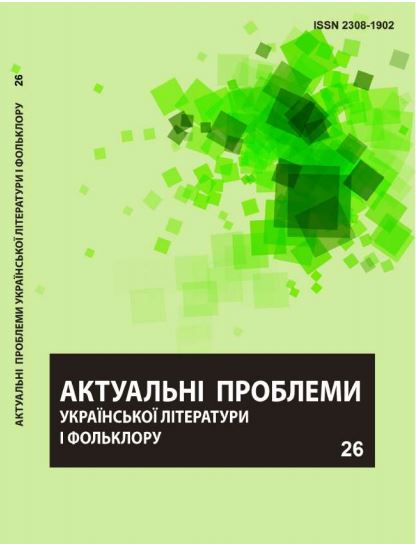Opposition Perun – Stryboh in the artist vision of Dara Korniy.
DOI:
https://doi.org/10.31558/2308-1902.2018.26.10Keywords:
mythology, paganism, pantheism, opposition, pantheon, tetralogyAbstract
The paper is based on the material of Dara Korniy’s four books «Reverse Sides», which confirms the author’s attention to the almost unknown, hidden, and it highlights the opposition of the pagan gods: Perun, the god of thunder and lightning, and Stryboh, the god of winds. Dara Korniy’s interpretation is compared with the pagan beliefs of ancestors to reveal the peculiarities of the author’s artistic thinking. It is found that the writer portrays the gods through the perception of other characters, and this gives her the opportunity to show them differently, often ambivalently, for example, Stryboh, who annihilated his lover when she left him. Dara Korniy emphasizes the inconsistency of actions, the ambivalence of actions in the image of the god of winds.
The author depicts the Bird with several hypostases as an intermediary between the pagan gods; this bird performs the role of the mirror in the opposition Perun – Stryboh. The Bird helps each of the gods to manifest their essence: Perun embodies the light, kind side, Stryboh - dark, vindictive.
The paper demonstrates that the artistic vision of Dara Korniy reflects the peculiarities of the individual and author’s perception of the pagan pantheon. According to the writer’s interpretation, the menacing ruler of the celestial elements, Stryboh, becomes virtuous due to the influence of love, but only for a certain time. By gaining new features, he shows up in the other world, though for a short spell. He manifests his dark nature soon and returns to the world of dark forces, killing his dearly beloved. The ambivalence of Stryboh’s image makes it possible to draw a conclusion on the instability of the boundaries of the good and evil, the transition possibility of the one into another. The writer is not inclined to oppose the characters, but she tries to find pieces of the unanimous whole in each of them, the dark and light, the good and evil simultaneously.
References
Берегова О. Символы славян. СПб. : Издательство «ДИЛЯ», 2011. 432 с.
Боровский Я. Мифологический мир древних киевлян. К. : Наукова думка. 1982. 104 с.
Вишневецька М. Міфопоетичний психоаналіз по-українськи (Дара Корній. Зворотний бік сутіні. Харків : Клуб сімейного дозвілля, 2016. 288 с.). 12.09.2017. URL: http://bukvoid.com.ua/reviews/books/2017/09/12/075050.html
Войтович В. Міфи та легенди давньої України. Тернопіль : Навчальна книга Богдан, 2005. 392 с.
Войтович В. Українська міфологія. К. : Либідь, 2002. 664 с.
Лозко Г. Українське язичництво. К. : Укр. центр духов. культури, 1994. 92 с.
Плачинда С. П. Словник давньоукраїнської міфології: К. : Укр. письменник, 1993. 63 с.
Попов М. И. Описание древняго славенскаго языческаго баснословия, собраннаго из разных писателей, и снабденнаго примечаниями. Б.м. : Salamandra P.V.V., 2010. 80 c.
Символы родов Расы великой. URL : https//img1.liveinternet.ru/images/attach/c/ 1/3781/3781164_swasolar.pdf
Славянская обережная и исцеляющая магия / авт.-сост. О. и Е. Крючковы. Москва : Велигор, 2016. 276 с.
Таранець В. Велесова книга (історико-лінгвістичне дослідження) : монографія. Одеса : Вид-во КП ОМД, 2015. 173 с.

